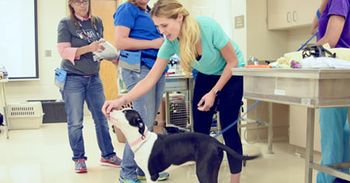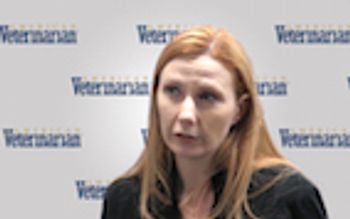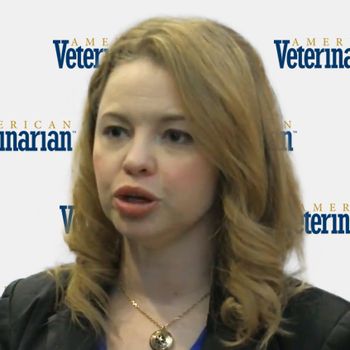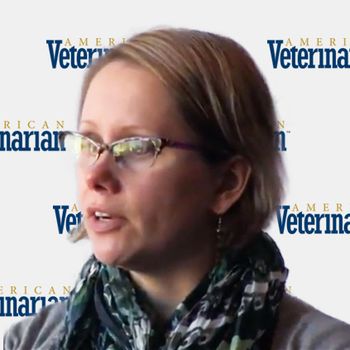
Sara L. Bennett, DVM, MS, DACVB, owner of Veterinary Behavior Consultations in Fort Branch, Indiana, explains how setting up a treatment plan for noise aversion in pets is a 3-step process.

Sara L. Bennett, DVM, MS, DACVB, owner of Veterinary Behavior Consultations in Fort Branch, Indiana, explains how setting up a treatment plan for noise aversion in pets is a 3-step process.

Get your online feline fix in five clips.

Sara L. Bennett, DVM, MS, DACVB, owner of Veterinary Behavior Consultations in Fort Branch, Indiana, says it is OK to pet your dog or cat when they are frightened by a noise event.

CVC educator Dr. Matt Brunke, CCRP, CVPP, CVA, explains why you should consider adding this multifactorial tool to your practice.

The 3 major principles to assist with maintaining doses “As Low As Reasonably Achievable” are time, distance, and shielding. Michael Bailey, DVM, DACVR, project manager for IDEXX, explains what each principle means for veterinary professionals when it comes to reducing radiation exposure.

Mikkel Becker shows CVC attendees how to treat to distract for blood draws. (Photo: Ryan Kramer)Nobody likes a needle, not even dogs.

Sara L. Bennett, DVM, MS, DACVB, owner of Veterinary Behavior Consultations in Fort Branch, Indiana, explains that dogs may display signs differently, which makes it hard for owners to recognize anxiety in their pets.

It can be a challenge to explain to cat owners how to give fluids subcutaneously (under the skin) to their cats.

Emily McCobb, DVM, MS, DACVAA, director of shelter medicine in the clinical sciences department at the Cummings School of Veterinary Medicine at Tufts University, says that one of the great things about shelter veterinarians is their ability to come up with a practical treatment plan for patients.

And you have these tools right there in your veterinary clinic, says Dr. Sue Ettinger.

Amanda Landis-Hanna, DVM, veterinary industry liaison, speaker, and consultant, discusses pain management drug Onsior, which provides safe, effective soft tissue surgery postoperative pain relief for cats and, just recently, dogs.

Although it's uncommon, you'll sometimes see a cat with signs of otitis externa. Use these practical tips so you're not fighting the allergies forever.

Ron Ofri, DVM, PhD, DECVO, professor of veterinary ophthalmology at the Hebrew University of Jerusalem, explains how different regions in the world have prevalent diseases based on what’s endemic in that specific area, as well as their geographical location.

Cats can get reobstructed due to ongoing inflammation or trauma from initial treatment, or other problems that may stem from a poor evaluation of the cat. Susan Little, DVM, DABVP (Feline), owner of Bytown Cat Hospital in Ontario, Canada, explains that if veterinarians aren’t careful, they can become a part of the problem.

Amanda Landis-Hanna, DVM, veterinary industry liaison, speaker, and consultant, talks about Galliprant, a molecule developed by Aratana that helps control pain and inflammation associated with osteoarthritis in dogs.

The farther you get away from a radiation source, the better. Michael Bailey, DVM, DACVR, project manager for IDEXX, expresses that if you’re wearing the proper gear, you can hold onto a pet getting a radiograph, but if you’re not holding onto the pet you should leave the exam room.

Susan Little, DVM, DABVP (Feline), owner of Bytown Cat Hospital in Ontario, Canada, says about one third of previously obstructed cats are likely to reobstruct in the future.

More than 1.2 million dogs every year are reported to have cranial cruciate disease. Amanda Landis-Hanna, DVM, veterinary industry liaison, speaker, and consultant, explains how a lot of things that veterinarians believe about this common disease are not always true.

CVC educator Wayne Usiak, AIA, shares his frustrations with clientsnot YOU, is it?

The hardest question you have to face as a pet owner. Dr. Mary Gardner wants to help your veterinary patients have a perfect ending to their perfect life.

Heather Wilson-Robles, DVM, DACVIM (Oncology), associate professor in the veterinary medicine and biomedical sciences department at Texas A&M University, discusses some of the limitations and challenges that she believes comparative oncology faces.

Ellen Lindell, VMD, DACVB, owner of Veterinary Behavior Consultations in Bethel, Connecticut, says veterinarians should consider how much impact they have on patients during exams—especially young patients.

Amanda Landis-Hanna, DVM, veterinary industry liaison, speaker, and consultant, talks about a session she attended at the 2017 Western Veterinary Conference that explained the tie between the feline gut and the feline brain.

Most health care professionals do not realize how important the concern about the potential risk of radiation exposure is to them. Michael Bailey, DVM, DACVR, project manager for IDEXX, says while it is hard to measure whether the Lower the Dose initiative has lowered peoples’ radiation exposure, he is confident that it has raised awareness.

Amanda Landis-Hanna, DVM, veterinary industry liaison, speaker, and consultant, talks about her experience volunteering at her local animal shelter while also working with a veterinarian at a practice when she graduated veterinary school.

CERENIA (maropitant citrate), which is an anti-nausea drug for dogs and cats from Zoetis, has been on the market for several years now. Amanda Landis-Hanna, DVM, veterinary industry liaison, speaker, and consultant, talks about how this anti-nausea drug improves both the human-animal bond as well as the quality of life of the patient.

Ask the dvm360/VHMA Practice Manager of the Year: Our veterinary practice doesn't handle conflict well. Is this normal?

Emily McCobb, DVM, MS, DACVAA, director of shelter medicine in the clinical sciences department at the Cummings School of Veterinary Medicine at Tufts University, says the goal for animal shelters is for them to become community resource centers that can target and help with specific animal-related issues.

Kristen Cooley, BA, CVT, VTS (Anes/Analgesia), instructional specialist at the University of Wisconsin School of Veterinary Medicine, says she prefers the term veterinary nurse because she believes it is more understood by the general public.

Amanda Landis-Hanna, DVM, veterinary industry liaison, speaker, and consultant, discusses what she has heard about the new Feliway Multicat product by Ceva Animal Health.